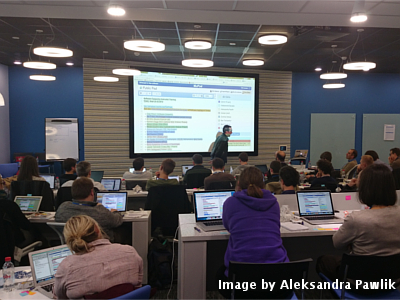Software Carpentry face-to-face Instructors Training at TGAC
Posted on 10 November 2014
Software Carpentry face-to-face Instructors Training at TGAC
 By Aleksandra Pawlik, Training Leader.
By Aleksandra Pawlik, Training Leader.
The second Software Carpentry face-to-face Instructors Training took place on 22-23 October in Norwich at The Genome Analysis Centre (TGAC). The course was taught by Greg Wilson, the founder of Software Carpentry and Bill Mills, the Mozilla Science Lab Community Manager. Over the next two days, 39 people learnt how to be better teachers.
The face-to-face Instructors Training is a much more intense and compact version of the course which Greg has been running online since 2012. Over the course of 48 hours, including the discussions over dinner at the end of Day One, we covered a number of topics about approaches, methods and challenges in teaching. Just like during the Software Carpentry workshops, the Instructors Training was very much hands-on.
One of the first things that the trainees were asked to do was a concept map. Initially they worked in pairs which provided them an opportunity to discuss how the others may perceive and understand the same concept. Then, using the multiple whiteboards available at TGAC's new cutting-edge training room, they drew up their concept maps for everyone to see and discuss. In the feedback, which was collected after every session, the concept maps were often mentioned as useful.
Another hands-on task, which was repeated on both days, was being filmed whilst teaching and receiving feedback. Much as what happened at the first face-to-face instructors training in Toronto in April this year, the trainees were divided into groups of three. Every person had to pick a topic to teach and deliver it during a short lesson which was filmed by one of the other two group members. Then it was time for feedback and watching oneself on the recording.
The former was definitely less painful than the latter. The first round of recordings left some of the trainees slightly traumatised. Seeing and listening to yourself on a video can be surprising, to say the least, but after we did the third round, ever more attendees seemed to feel comfortable with the situation. They managed to forget about their awkwardness and focus on the way they delivered the material.
Most of the course was focused around those teaching skills which are not specific to computing. In fact, at the end, one participant said she would apply what she learnt in teaching other subjects at her home institution. On the afternoon of Day 2 we looked closer at some topics particular to Software Carpentry, including the current structure of the repository containing the lesson material.
On the one hand, it was a practical introduction to one of the core instructors' tasks: setting up repositories for workshops. On the other hand, it was a good opportunity to discuss the collaborative development of teaching materials, a goal which the Software Carpentry community has been actively pursuing.
At the end of Day two it was clear that the information load was quite overwhelming. Yet, at least from my own experience, I know that it takes some time for all this knowledge to sink in. The skills needed for being a good Software Carpentry instructor develop with every workshop. However, the instructors training is like a catalyst and also helps with damage management. The training helps you learn not only how to be a better teacher but also how not to be be a bad one - someone who, even unwittingly, may discourage students from the subject which could potentially become their passion.

